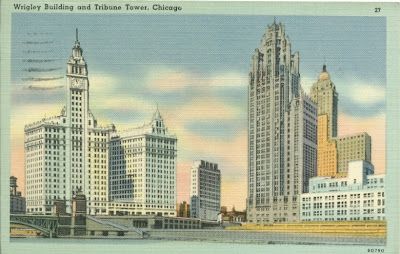Two of the best-known structures in Chicago are the Wrigley Building and Wrigley Field.
So what does it say that after next year, the William Wrigley Jr. Co. won’t have any connection to either building?
TIME PASSES. THINGS change. Nothing is permanent, not even our memories – which wither away with the passage of the years.
Now the Wrigleys haven’t had anything to do with the Chicago Cubs or their Lakeview neighborhood stadium for three decades when the family sold the ballclub (but got the Tribune Co. to agree to keep the old name – sparing us the abomination of seeing bad baseball played at Tribune Park).
Last week, the Wrigley company made it known that it was doing away with their skyscraper (although by modern construction standards, Wrigley merely tickles the sky) corporate offices on Michigan Avenue. They plan to have everybody who works for the company out of the structure (which never fails to amuse me all the times it appears in the background of those "M Squad" re-runs starring Lee Marvin as rough-tough Chicago cop Frank Ballinger) by the end of next year.
There will be generations of Chicagoans who will always think of the white tower on the northern shore of the Chicago River as the Wrigley Building, even though there won’t really be anything “Wrigley” about it.
JUST AS I’M sure that when the day comes that the Chicago Cubs undertake the major overhaul of their stadium to ensure it can remain in use for decades to come, it will keep the “Wrigley” name.
It must be nice to be a company so well entrenched in the image of Chicago that its name will live on in these structures long after they have fallen into other corporate hands.
It will help that Wrigley isn’t leaving Chicago. In fact, they have already completed much of their corporate shift away from the Near North Side to the fringes of the Lincoln Park neighborhood at Goose Island.
Wrigley built a corporate campus at that site nearly a decade ago, and already has much of its staff working out of that plant. The newly-announced move is merely a completion of the shift.
IT MAY ALSO make sense in getting away from a structure that is very much a product of early 20th Century Chicago. The very need to be in downtown Chicago is a concept some consider to be obsolete – perhaps those same people who boast that the new Wrigley campus includes a physical fitness center (a.k.a., a gym) for employee use.
I’m not ridiculing that concept just because my own physique clearly shows I could afford to spend more time in a gymnasium (or perhaps on a running track).
It’s just that I feel a slight twinge of nostalgia at the thought that Wrigley (as in company) won’t be at Wrigley (as in building) for much longer.
The Wrigley Building will get some Chicagoans who will be stubborn and keep referring to it by that name – regardless of what the structure winds up being called officially (just as some insist on referring to the city’s tallest building as the Sears Tower; and consider that official name to be a virtual curse word).
BUT EVENTUALLY, WE’LL get younger generations who will let it wither away. That fact may well be natural. Time passes. Nothing is permanent.
Considering the speculation that the structure may be turned (at least in part) into high-priced residences (the Wrigley condos?), I wonder if some future resident will have a clue as to the dealings that once occurred in the room they will someday sleep in.
One other thought pops into my head – the fact that when a song was crafted for Frank Sinatra to sing about Chicago in the film “Robin and the Seven Hoods,” one of the two places specifically cited in “My Kind of Town” was the Wrigley Building (with the Union Stockyards being the other).
The stockyards departed the South Side some four decades ago. After next year, the Wrigley Building may be gone too.
-30-



No comments:
Post a Comment